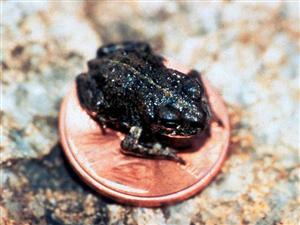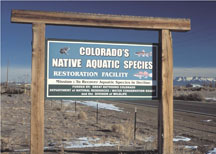About the Boreal Toad
Once common in montane habitats between 7,000-12,000 feet in the Southern Rocky Mountains, the boreal toad (Anaxyrus boreas boreas) has experienced dramatic population declines over the past two decades. The declines appear to be related to infection by the chytrid fungus Batrachochytrium dendrobatidis (Bd), which can cause a disease with a very high mortality rate. Other factors such as habitat loss may also play a role.
The boreal toad is presently listed as an endangered species by the states of Colorado and New Mexico and is a protected species in Wyoming. The U.S. Fish and Wildlife Service (FWS) classified the Southern Rocky Mountain population of the boreal toad in 1995 as a candidate species for federal listing under the Endangered Species Act. In 2005, this designation was removed while the genetic distinctness of the Southern Rocky Mountain population was reevaluated. In 2012, the FWS issued a 90-day finding and initiated a status review, the result of which is due no later than Federal fiscal year 2017.
Conservation Update
In 2014, Colorado Parks and Wildlife biologists documented natural breeding in a translocated population of boreal toads near Cameron Pass. Six years after introduction of the first tadpoles, this is the first translocation effort that has resulted in known natural breeding. This is a very significant development and an essential step in establishing what may become the first fully successful translocated boreal toad population. Two other active translocation efforts are ongoing in Colorado and New Mexico, but to date, natural reproduction has not been detected at those locations.
Boreal Toad Research
Although Colorado Parks and Wildlife is not actively conducting boreal toad research at this time, the agency has devoted significant resources in the past two decades toward researching the cause of boreal toad declines in the state and exploring ways to recover the species. 
Specifically, CPW researchers focused on developing methodologies for reintroducing toads in historically occupied habitats, detecting Bd in the wild, marking and identifying individual toads, and improving breeding success at the Native Aquatic Species Restoration Facility in Alamosa.
Most recently, in 2012, CPW researchers and biologists partnered with Dr. Larissa Bailey at Colorado State University to define the survey effort required to determine if toads occupied potential boreal toad breeding sites. CPW then applied this survey methodology to search for suitable habitat for new toad populations and to identify potential translocation sites. Presently, there are several potential translocation sites in Colorado that are being monitored for Bd. Provided the deadly fungus is not found at these sites, these will likely become new translocation sites.
 Colorado Parks and Wildlife's Native Aquatic Species Restoration Facility (NASRF) plays a critical role in the state's efforts to restore boreal toads. The facility houses over 700 adult boreal toads, providing a key link in the production of these animals for translocation efforts and research, as well as serving as a genetic bank for this state endangered species. Protocols used in maintaining boreal toads at NASRF can be found in the Boreal Toad Husbandry Manual.
Colorado Parks and Wildlife's Native Aquatic Species Restoration Facility (NASRF) plays a critical role in the state's efforts to restore boreal toads. The facility houses over 700 adult boreal toads, providing a key link in the production of these animals for translocation efforts and research, as well as serving as a genetic bank for this state endangered species. Protocols used in maintaining boreal toads at NASRF can be found in the Boreal Toad Husbandry Manual.

Researchers from CPW and Cheyenne Mountain Zoo in Colorado Springs also investigated methods for identifying individual boreal toads, which can help researchers estimate survival, movement, abundance and recruitment. Boreal toads display unique markings on their bellies, which researchers determined could be used to successfully identify individual animals. Using digital photographs, researchers catalogued all toads housed at NASRF to help ensure the integrity of the breeding program there.
Research Results:
History of Boreal Toad Conservation
When the state listed the boreal toad as endangered in 1993, Colorado Parks and Wildlife (formerly Colorado Division of Wildlife) developed a recovery plan for the boreal toad in 1994 and an interagency recovery team was formed that same year. In 1998, the existing Recovery Plan was updated and combined with an existing draft Conservation Strategy to create a comprehensive Boreal Toad Conservation Plan for the Southern Rocky Mountains. As part of the conservation planning process, Conservation Agreements were signed by eight state and federal agencies and the Colorado Natural Heritage Program. The agreements outlined and confirmed respective roles in implementing the Conservation Plan. A revised and updated version of the Boreal Toad Conservation Plan was completed in 2001.
 The decline of the boreal toad is not unique; amphibians around the globe are experiencing alarming declines. Of the over 3,000 species of amphibian species, 39 percent are threatened with extinction. This contrasts sharply with the status of threatened birds (10 percent) or mammals (16 percent). Causes of these declines are discussed in "Disappearing jewels: the status of New World amphibians".
The decline of the boreal toad is not unique; amphibians around the globe are experiencing alarming declines. Of the over 3,000 species of amphibian species, 39 percent are threatened with extinction. This contrasts sharply with the status of threatened birds (10 percent) or mammals (16 percent). Causes of these declines are discussed in "Disappearing jewels: the status of New World amphibians".
Recent findings suggest that the chytrid fungus Bd may be responsible for more declines than previously thought. A discussion of specific factors limiting the recovery of boreal toads in particular as well as conservation systematics can be found in Michael Lannoo, ed., "Amphibian Declines: The Conservation Status of United States Species" (Berkeley: University of California Press, 2005).
Reports on conservation activities and status:
Additional useful documents:
Additional useful link:

